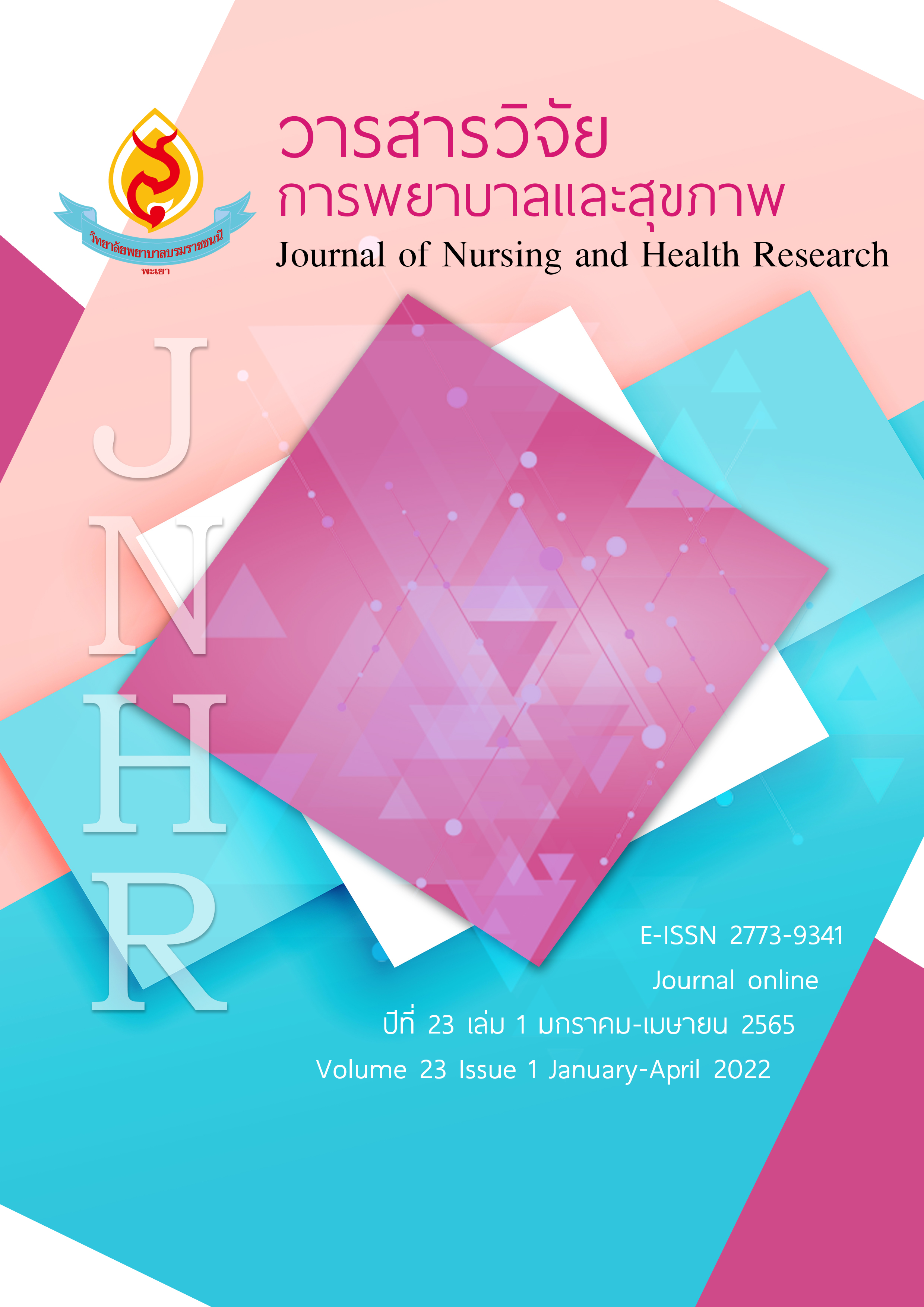ปัจจัยที่มีความสัมพันธ์กับการสูญเสียสมรรถภาพการได้ยินจากเสียงดังในพนักงาน โรงงานผลิตข้าวโพดบรรจุกระป๋อง
คำสำคัญ:
การสูญเสียสมรรถภาพการได้ยิน, ระดับเสียงดัง, พนักงานโรงงานบทคัดย่อ
การวิจัยนี้มีวัตถุประสงค์เพื่อประเมินระดับเสียงดังในพื้นที่ทำงานโรงงานผลิตข้าวโพดบรรจุกระป๋องแห่งหนึ่ง และหาความชุกและปัจจัยที่มีความสัมพันธ์กับการสูญเสียสมรรถภาพการได้ยินจากเสียงดัง (Noise-induced hearing loss; NIHL) ในพนักงานโรงงานข้าวโพดบรรจุกระป๋อง เก็บข้อมูลโดยการตรวจวัดระดับเสียงในบริเวณพื้นที่ทำงาน กลุ่มตัวอย่างเป็นคนงานในโรงงานข้าวโพดบรรจุกระป๋อง จำนวน 265 คน เก็บตัวอย่างข้อมูลส่วนบุคคลโดยใช้แบบสอบถาม และการตรวจวัดสมรรถภาพการได้ยินโดยแพทย์อาชีวเวชศาสตร์ เพื่อหาความชุกการสูญเสียสมรรถภาพการได้ยินจากเสียงดัง วิเคราะห์ข้อมูลสถิติโดยใช้ chi-square test และ odds ratio (95% CI) ผลการศึกษา พบว่าความชุกการสูญเสียสมรรถภาพการได้ยินจากเสียงดัง ร้อยละ 21.13 ส่วนใหญ่มีระดับการได้ยินผิดปกติในช่วงความถี่ 4,000-6,000 Hz ระดับความดังเสียงเฉลี่ยภายในพื้นที่ทำงานตลอดระยะเวลาทำงาน (Time Weighted Average-TWA) 8 ชั่วโมงทำงาน อยู่ในช่วง 72.8 -95.8 dBA และพบว่าบริเวณพื้นที่ทำงาน 8 SEG จากทั้งหมด 16 SEG มีความดังเสียงเฉลี่ยเกินมาตรฐานกฎหมายกำหนด (มากกว่า 85 dBA) บริเวณที่มีระดับเสียงเฉลี่ยดังที่สุด 3 อันดับแรกได้แก่ บริเวณเตรียมการข้าวโพดบรรจุกระป๋อง ผลิตข้าวโพดบรรจุกระป๋อง และ เตรียมการข้าวโพด บรรจุถุงสุญญากาศ ตามลำดับ ปัจจัยที่มีความสัมพันธ์กับการสูญเสียสมรรถภาพการได้ยินจากเสียงดังอย่างมีนัยสำคัญทางสถิติที่ระดับ 0.05 ได้แก่ อายุ (OR=3.31, 95% CI, 1.80-6.09) ระยะเวลาการสัมผัสเสียงดัง (OR=3.00, 95% CI, 1.07-5.69) การสัมผัสเสียงดังเกิน 85 dBA (OR=2.38, 95% CI, 1.28-4.46) และชั่วโมงการทำงานต่อวัน (OR=1.96, 95% CI, 1.08-3.57) ผู้บริหารโรงงานผลิตข้าวโพดบรรจุกระป๋องควรให้ความสำคัญกับการปรับปรุงทางด้านวิศวกรรมของเครื่องจักรเพื่อลดระดับเสียงดังในพื้นที่ทำงาน และมีการบริหารจัดการเพื่อลดระยะเวลาการสัมผัสเสียงให้แก่พนักงานที่อยู่ในพื้นที่ทำงานที่มีเสียงดังเกิน 85 dBA
เอกสารอ้างอิง
กนกวรรณ อาจแก้ว, วิชัย พฤกษ์ธาราธิกูล และสุนิสา ชายเกลี้ยง. (2563). ความชุกของการสูญเสียการได้ยินและการสัมผัสเสียงของพนักงานผลิตชิ้นส่วนเครื่องปรับอากาศและอุปกรณ์ทำความเย็น. วารสารสาธารณสุขมหาวิทยาลัยบูรพา, 15(1),1-13.
กระทรวงพาณิชย์. (2563). มูลค่าการส่งออก การนำเข้า และดุลการค้าของไทย (รายเดือน). สืบค้นเมื่อ 1 พฤศจิกายน 2564, จาก http://www.ops3.moc.go.th/infor/MenuComTH/stru1_export/ export_topn_re/report.asp
จิราพร ประกายรุ้งทอง และสุวัฒนา เกิดม่วง. (2560). ปัจจัยที่มีความสัมพันธ์ต่อการสูญเสียการได้ยินจากการทำงาน ในกลุ่มคนงานโรงงานอุตสาหกรรมผลิตชิ้นส่วนรถยนต์ จังหวัดสุพรรณบุรี. วารสารการพยาบาลและการดูแลสุขภาพ, 35(3), 98-108.
ธีระศิษฏ์ เฉินบำรุง, วิทยา พิเชฐวีรชัย, ศิรินทิพย์ ชาญด้วยวิทย์, วนิดา อิณชิต และวันทนี หวานระรื่น. (2561).การเกิดร่องและขนาดของร่องที่พบได้จากการตรวจสมรรถภาพการได้ยินประจำปีของพนักงานจากสถานประกอบการ 9 แห่งในจังหวัดระยอง ประเทศไทย.วารสารสาธารณสุขศาสตร์. 48(1), 33-43.
ประกาศกรมสวัสดิการและคุ้มครองแรงงานเรื่อง มาตรฐานระดับเสียงที่ยอมให้ลูกจ้างได้รับเฉลี่ยตลอดระยะเวลาการทำงานในแต่ละวัน. (2561, 26 มกราคม). ราชกิจจานุเบกษา. เล่ม 135 ตอนพิเศษ 19ง, หน้า 15.
ประกาศกรมสวัสดิการและคุ้มครองแรงงานเรื่องหลักเกณฑ์และวิธีการจัดทำมาตรการอนุรักษ์การได้ยินในสถานประกอบกิจการ. (2561, 12 มิถุนายน). ราชกิจจานุเบกษา. เล่ม 135 ตอนพิเศษ 134 ง, หน้า 15.
สำนักงานประกันสังคม. (มิถุนายน 2564). สถานการณ์การประสบอันตรายหรือเจ็บป่วยเนื่องจากการทำงาน ปี 2559-2563. สืบค้นเมื่อ 1 พฤศจิกายน 2564, จาก https://www.sso.go.th/wpr/assets/upload/ files_storage/sso_th/5ebe42693bf27ca624d2a14a89f99223.pdf
สุธาสินี ศรีนุ่น, สมเจต บุญสิงห์, รสรินทร์ สกุลพราหมณ์ และมนพร ชาติชำนิ. (2556). การศึกษาการเกิดประสาทหูเสื่อมของผู้ปฏิบัติการในอากาศ กองทัพเรือ. เวชสารแพทย์ทหารบก. 66(2), 69-77.
อริสรา ฤทธิ์งาม, เจนจิรา เจริญการไกร, สุวรรณา จันทร์ประเสริฐ และจันทร์ทิพย์ อินทวงศ์. (2559). ปัจจัยที่สัมพันธ์กับการสูญเสียการได้ยินในพนักงานโรงงานอุตสาหกรรมแปรรูปยางธรรมชาติ จังหวัดระยอง. วารสารพยาบาลสาธารณสุข, 30(3), 118-131.
Chen, Y., Zhang, M., Qiu, W., Sun, X., Wang, X., Dong, Y., Chen, Z., …, Hu, W. (2019). Prevalence and determinants of noise-induced hearing loss among workers in the automotive industry in China: a pilot study. Journal of Occupational Health, 61(5), 387–397. Doi: 10.1002/1348-9585.12066
Hon, C. Y., Tchernikov, I., Fairclough, C., & Behar, A. (2020). Case study in a working environment highlighting the divergence between noise intensity and workers' perception towards noise. International Journal of Environmental Research and Public Health, 17(17), 6122. doi: 10.33 90/ijerph17176122
Hong, J. W., Jeon, J. H., Ku, C. R., Noh, J. H., Yoo, H. J., & Kim, D. J. (2015). The prevalence and factors associated with hearing impairment in the Korean adults: the 2010-2012 Korea national health and nutrition examination survey (observational study). Medicine, 94(10), e611. doi: 10.1097/MD.0000000000000611.
Krejcie, R. V., & Morgan, D. W. (1970). Determining sample size for research activities. Educational and Psychological Measurement, 30(3), 607–610.
Maqsood, N., Younes, I., & Minallah, M. (2019). Industrial noise pollution and its impact on the hearing capacity of workers: A case study of Gujranwala city, Pakistan. International Journal of Economic and Environmental Geology. 10(2), 45-49.doi: 10.46660/ojs.v10i2.261
National institute for occupational safety and health. (NIOSH), U.S. Department of health and human Services. (1998). Occupational noise exposure: Revised Criteria 1998, Cincinnati Ohio: NIOSH publication.
Peelle, J. E., & Wingfield, A. (2016). The neural consequences of age-related hearing loss. Trends in Neurosciences, 39(7), 486-497. doi.org/10.1016/j.tins.2016.05.001
Paudel, D., Bhandary, S., Pokharel, A., Chettri, S., Shah, S., Sah, B., …, Manandhar, S. (2019). Noise induced hearing loss among factory workers of Dharan industrial area. Journal of BP Koirala Institute of Health Sciences, 2(2), 34–39. doi.org/10.3126/jbpkihs.v2i2.27856
Thongtip S., Sangkham S., & Sukpromson R. (2020) Factors associated with occupational hearing loss among stone-mortar Workers in Phayao province, northern Thailand. Journal of Health Science Medical Research, 38(3), 213-219. doi: 10.31584/jhsmr.2020740
Tahir N., Aljunid S.M., Hashim J.H., & Begum J. (2014). Burden of noise induced hearing loss among manufacturing industrial workers in Malaysia. Iranian Journal Public Health, 43(3), 148-153.
Wangchuk P., & Dendup P. (2020). Prevalence of occupational noise induced hearing loss among industrial workers in Bhutan. Bhutan Health Journal. 6(1), 25-30. doi.org/10.47811/bhj.96
World Health Organization. (2018). Addressing the rising prevalence of hearing loss. Geneva: World health organization, 2018.
ดาวน์โหลด
เผยแพร่แล้ว
รูปแบบการอ้างอิง
ฉบับ
ประเภทบทความ
สัญญาอนุญาต
ลิขสิทธิ์ (c) 2022 วารสารวิจัยการพยาบาลและสุขภาพ

อนุญาตภายใต้เงื่อนไข Creative Commons Attribution-NonCommercial-NoDerivatives 4.0 International License.



